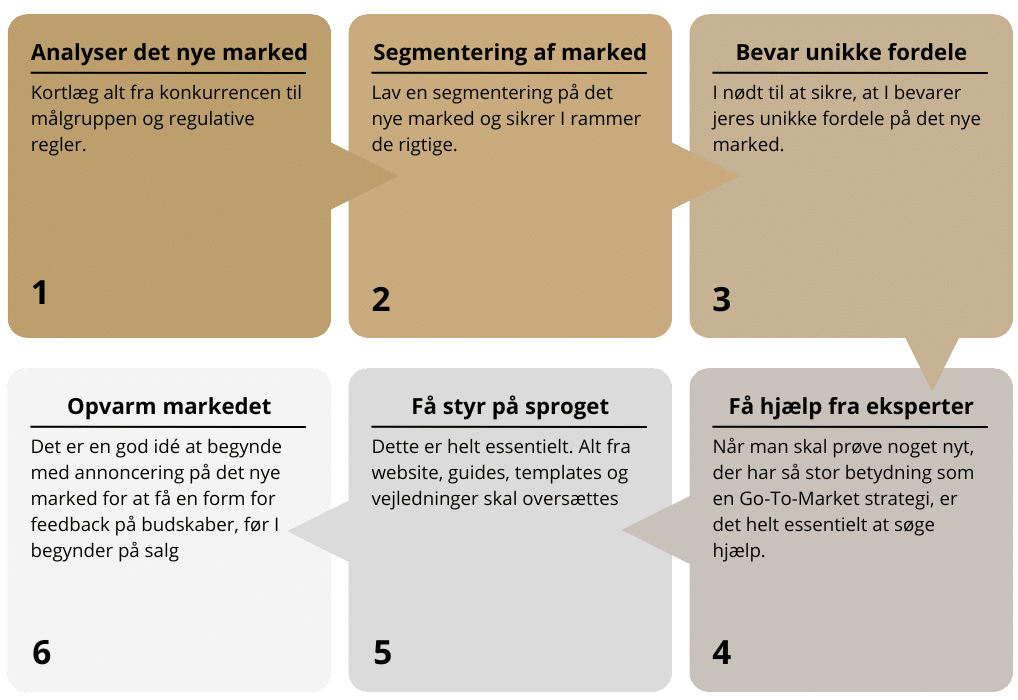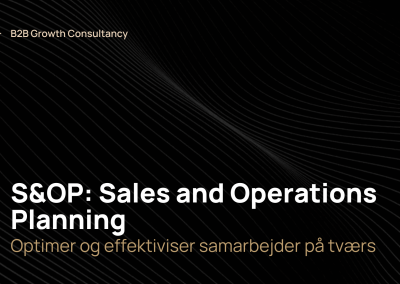A go-to-market strategy, also known as a GTM strategy, is a plan for how a company enters a market or gains more of a market.
In this guide, we will discuss what a go-to-market strategy is and how to create and implement a GTM strategy in your business. Specifically, we look at:
- What is a go-to-market (GTM) strategy?
- Key elements of a go-to-market plan
- 6 tips for your go-to-market strategy
- Which GTM strategy should you go with?
- How to get started with your GTM strategy
- Optimize your product launch with Radiant
What is a go-to-market (GTM) strategy?
A go-to-market (GTM) strategy is a plan that guides the launch of a new product, service or brand in a market. The plan is crucial for introducing and positioning the product, service or brand and ensuring the company’s success in the chosen market.
Når man udarbejder en go-to-market strategi, er det helt essentielt at have et stort kendskab til markedet, konkurrencen, og hvordan kunderejsen ser ud – med andre ord skal man gennemføre en markedsanalyse.
A GTM strategy is not just a marketing plan; it connects product development, sales, marketing and customer service in a cohesive approach that must be implemented with care and precision.
This strategy defines how you reach customers and communicate the value of the product and which sales and distribution channels to use. It must be tailored to reflect the product’s unique value proposition and the company’s overall business goals.
To the right is an example of a go-to-market strategy where you first do a market analysis, including competitor analysis and segmentation. Next, you put together your USPs and differentiate yourself from the competition. You then draft which channels to look into and then test everything and provide feedback on the strategy. In the end, you have your go-to-market strategy fully developed.

Hør vores afsnit om internationalt B2B-salg fra podcasten Oplev Salg
Her deler Vice President i Queue-it Mie Elmkvist, og CEO af Radiant Joakim Steenfos, deres oplevelser og erfaringer med at tage salg til nye markeder.
Vigtige elementer i en go-to-market plan
Et nyt studie fra McKinsey viser, at hvis man har styr på nedenstående 4 “dominobrikker”, som de kaldes, øges afkastet på ens GTM-strategi med 20%.
In the article they describe how to:
- Centralize commercial processes to gain insights – you can do this with HubSpot, for example
- Has an agile approach to its go-to-market strategy, including an omnichannel strategy
- Improve processes with automations and AI for sales
- Train colleagues in the new strategy
Med disse 4 “dominobrikker” har I altså større mulighed for at skabe en vellykket GTM-strategi.
The above is something you work with in any go-to-market strategy. Likewise, you should also always ensure that the following are met:
- A useful segmentation Who is the customer and what characterizes them?
- Understand the customer buying journey; which touchpoints influence the decision-making process and buying behavior?
- Defining the value proposition; how does your product differentiate itself from the competition and what unique value does it offer?
- Establishing sales and distribution channels; what are the most effective ways to reach the customer and deliver value?
- Setting KPIs and success measures; this is crucial to measure the effectiveness of your GTM strategy and make adjustments – here you can use a dashboard to keep track of these KPIs.
All elements are key. Of course, some will be weighted higher than others, but it’s all something you should consider internally.
6 tips for your go-to-market strategy
With experience in creating go-to-market strategies for a wide range of companies, we’ve gathered the best advice for you right here.
1. Analyze the new market
To be successful with your GTM strategy, it is crucial to analyze the market you are aiming to enter. In this analysis, you map out everything from the competition to the target audience and what regulatory rules might affect the launch of your product.
Read more about market analysis
2. Create a new segmentation of the new market
There’s no guarantee that you’ll be working with the same stakeholders in the new market that you’ve worked with before.
A concrete example is the difference between departments in different countries. For example, the US has different departments with different responsibilities than the EU – these differences can also be found between Eastern and Northern Europe.
Read more about segmentation
3. Maintain your unique advantages
You may have certain USPs in one market, but you may not have the same USPs in the new market.
There may be other things that are relevant in this market, but it could also be that your competitors have the same advantages as you. Therefore, you need to ensure that you maintain your unique advantages in the new market.
4. Get help from experts
Når I skal prøve noget nyt, der har så stor betydning som en go-to-market strategi, er det helt essentielt at søge hjælp.
You can benefit from seeking expert help:
- The embassy of the country in question
- Other Danish companies in the country in question
- Experts who specialize in go-to-market strategies
At Radiant, we can present you with the challenges and opportunities you need to be aware of based on experience and best practices.
5. Get a grip on the language
If you have a physical product or software with manuals, guides and templates, make sure the language is consistent with the language of the market you want to enter. Of course, it’s always a good idea to translate your website so that it’s ready for users from the new country.
When it comes to manuals, you need to pay extra attention to getting it 100% right so that the user experience is top notch from the start.
6. Warm up the market before sales begin
It’s a good idea to start advertising in the new market to get some feedback on messages before you start selling. After all, it’s cheaper to test with ads than it is with man hours.
By advertising to the new market, you can 1) see which messages appeal best to the target audience and 2) Warm up the market to make it easier for sales to start.
Her kan I f.eks. gøre brug af Audiences i HubSpot, så du kan annoncere til præcis de rigtige personer eller virksomheder. På den måde er du sikker på, at de rigtige personer ser dine annoncer. Du kan se, hvordan du gør, i denne guide.
Which GTM strategy should you go with?
Der findes forskellige GTM-strategier, som hver især har forskellige fordele og ulemper. Herunder kan du se nogle af de strategier, I bør overveje. Den rigtige strategi, når man skal ekspandere til et andet land, afhænger af markedet, forbruger-behov, konkurrenterne og mange andre variabler. Derfor kan og skal du udelukkende se nedenstående som inspiration. For nærmere rådgivning omkring hvordan du skal ekspandere til et nyt marked, kan du kontakte os.
New product innovation
If you are an expert in a field and have innovated a new product, this can be a strong GTM strategy to build on.
Innovation fører til fordele og smartere løsninger. Men det kan være dyrt at innovere, og hvis det er en helt ny teknologi, tager det også tid at uddanne markedet i denne. Det er derfor meget vigtigt, I bruger god tid på jeres GTM-strategi og søger hjælp, når I har brug for det.
Prize competition
Are you cheaper than the alternative and can offer a good price without compromising on quality? Then you have a big advantage in your go-to-market strategy.
Being able to offer a cheaper solution is one of the strongest USPs you can have – especially if it doesn’t compromise on quality.
Digital marketing
If you have strong digital marketing resources, including SEO and paid ads, you can also use these resources to enter a new market. By capturing relevant keywords in the new market, you can quickly gather relevant traffic, which you slowly start to convert into customers or leads to sales.
These are three different go-to-market strategies that you can use if you are considering expanding into new markets.
Read more about digital marketing
How to get started with your GTM strategy
Implementing a go-to-market (GTM) strategy requires a lot of coordination across the organization. It’s important that everyone in the company is aware of what the goal is and how to communicate it.
The core elements of the implementation phase include rolling out marketing materials, training the sales team and setting up customer service structures. This means that sales, marketing and customer service need time to prepare for this.
Gathering customer feedback and market insights early in the process is essential for gathering customer feedback and market insights. These insights can then be used to improve your go-to-market strategy, adjust the marketing message and refine the sales process.
To ensure successful implementation, there must be a dedicated GTM management team that monitors progress against the set KPIs and goals. Ongoing reporting and evaluations should be done to identify any bottlenecks and ensure that the strategy remains aligned with the company’s overall goals and vision.
4 trin til at måle på og optimere sin GTM-strategi
At måle effekten af din go-to-market (GTM)-strategi er afgørende for at forstå, om I gør fremskridt og arbejder mod jeres mål. Effektiv måling giver jer indsigt i, om strategien skaber de ønskede resultater og forbedrer jeres markedsføring og salgsindsatser.
Det kræver, at I identificerer de rette målepunkter og KPI’er, som kan give jer den nødvendige indsigt til at evaluere og optimere jeres GTM-strategi. Her er en trinvis vejledning til at måle på jeres GTM-strategi:
1. Definér klare mål
Før I kan begynde at måle, skal I definere jeres specifikke målsætninger for GTM-strategien. Dette kan inkludere:
- At øge antallet af leads
- At forbedre konverteringsraten
- At reducere omkostningerne ved kundetilgang
- At øge virksomhedens markedsandele
Ved at fastsætte klare og konkrete mål sikrer I, at jeres målinger fokuserer på det vigtigste og giver en tydelig retning for jeres indsats.
2. Identificér relevante KPI’er
Når målene er fastsat, skal I vælge de KPI’er (Key Performance Indicators), der er mest relevante for at måle jeres succes. Eksempler på KPI’er til GTM-strategier kan være:
- Antallet af genererede leads
- Konverteringsraten fra leads til kunder
- Omkostninger pr. kundetilgang (Customer Acquisition Cost – CAC)
- Øgede markedsandele
- Customer Lifetime Value (CLV)
- Return on Investment (ROI) fra marketingkampagner
De rette KPI’er giver jer specifikke data at arbejde med og gør det muligt at vurdere, om strategien lever op til målene.
3. Brug data til at evaluere KPI’er
Når KPI’erne er på plads, skal I indsamle og analysere relevante data, som kan hjælpe jer med at evaluere strategiens resultater. Dette kan omfatte data fra:
- Marketingkampagner og salgsaktiviteter
- Webanalyse og kundeoplevelser
- Kundetilfredshedsundersøgelser og loyalitetsmålinger
Brug disse data til at evaluere, hvordan jeres GTM-strategi præsterer, og hvor der kan være behov for forbedringer.
4. Justér løbende jeres GTM-strategi
Når evalueringen viser områder, hvor der er potentiale for forbedring, skal I foretage justeringer i strategien. Dette kan være ændringer i jeres kommunikationskanaler, jeres prissætning eller jeres målgruppefokus.
GTM er en iterativ proces, hvilket betyder, at løbende optimering er en vigtig del af succesen. Planlæg faste intervaller for at evaluere jeres KPI’er, og følg op på, om de justeringer, I har foretaget, har skabt de ønskede forbedringer.
Optimize your product launch with Radiant
Hos Radiant er vi eksperter i B2B-salg og i at hjælpe virksomheder med at komme ind på DACH- og det nordiske marked. I skrivende stund hjælper vi mere end 20 virksomheder med at vækste gennem eksekvering af salg eller optimering af processer i deres HubSpot.
We solve growth problems through sales execution – also known as sales as a service – or by optimizing processes through HubSpot as a Service.
Mød én nogle af vores Go-To-Market eksperter

Christoffer Tofte
Christoffer har indgående erfaring med salg indenfor B2B salg på tværs af vertikalerne; Finance, Professional Services, Tech og SaaS. Christoffer har herunder erfaring med Go-To-Market strategier og hjælper virksomheder med at lykkes i Norden og Dach regionen med vores Sales go to Market-løsning.



